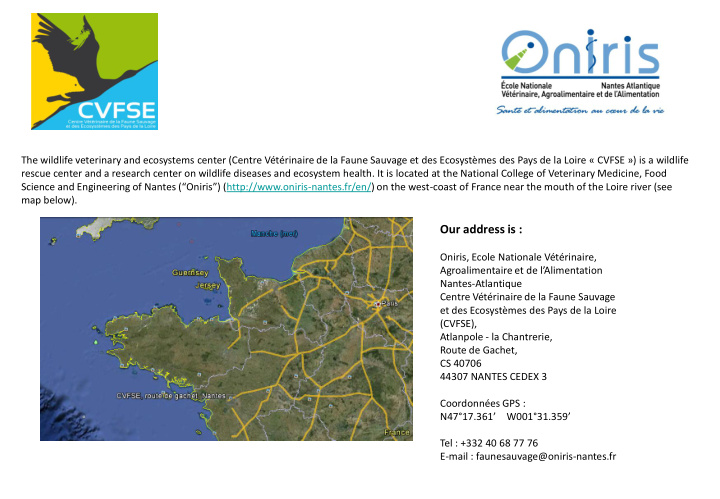



The wildlife veterinary and ecosystems center (Centre Vétérinaire de la Faune Sauvage et des Ecosystèmes des Pays de la Loire « CVFSE ») is a wildlife rescue center and a research center on wildlife diseases and ecosystem health. It is located at the National College of Veterinary Medicine, Food Science and Engineering of Nantes (“Oniris”) ( http://www.oniris-nantes.fr/en/) on the west-coast of France near the mouth of the Loire river (see map below). Our address is : Oniris, Ecole Nationale Vétérinaire, Agroalimentaire et de l’Alimentation Nantes-Atlantique Centre Vétérinaire de la Faune Sauvage et des Ecosystèmes des Pays de la Loire (CVFSE), Atlanpole - la Chantrerie, Route de Gachet, CS 40706 44307 NANTES CEDEX 3 Coordonnées GPS : N47° 17.361’ W001° 31.359’ Tel : +332 40 68 77 76 E-mail : faunesauvage@oniris-nantes.fr
Wildlife rehabilitation was the first activity of the CVFSE and remains today an important one. Founded in 1985, the CVFSE received, this first year, 18 animals. For this time, more and more animals are admitted in care and at the moment more than 1500 animals are admitted each year.
Most of these are birds, mainly raptors, sea birds and passerines and small mammals also like hedgehogs. The CVFSE is able to deal with oiled birds in case of oil spill on the Atlantic coast or in the Channel and is the main French contact of the Sea Alarm foundation. Thousands of oiled birds were then admitted in care in 1999-2000 during the Erika oil spill and the CFVSE was also involved at the time of the Tricolore (2002) and Prestige (2002) accidents.
To take care of diseased or wounded wild animals, the CVFSE has all the needed facilities included two hospital rooms, a treatment room, a surgery room, a pharmacy, a small lab for routine analyses and a washing room with a washing machine for oiled birds. For reeducation before release, aviaries and pounds are also available. 50 to 55 % of the treated animals are thus released each year and reintroduced into the wild.
Since more than ten years now, three other activities have been developed. Firstly, the CVFSE welcome pupils from primary to high school and public for education and sensibilisation about biodiversity conservation. Conferences and guided tours of the center are then organized. Thanks to its localization at Oniris, vet students come also, as volunteers or for training courses to learn wildlife medicine and surgery. Courses for professionals or veterinarians working with native European wildlife are also performed recently. Secondly, the CVFSE is now a research center on wildlife diseases and ecosystem health. Topics covered by the research team are the use of wild animals or bees as sentinel of the environmental pollution (HAPs, heavy metal, pesticides, rodenticides,…) in North -West France, the prevention of hospital-acquired and zoonotic infections for wild animals in care and the medical staff respectively, and the development of the epidemiosurveillance capabilities of the wildlife rehabilitation centers in France. Finally, the CVFSE brings its skills in epidemiology and in wildlife medicine and surgery on request. Epidemiological surveys, anesthesia and surgery for sampling or transmitter implantation have thus been done in recent times.
The CVFSE staff : Olivier Lambert, biologist director Philippe Gourlay veterinarian Mélanie Piroux PhD student working on the bee’s ecology Delphine Teissedre and Caroline Ladan animal keepers and nurses Elodie Laurent voluntary community worker as animal keeper and public relation We also welcome volunteers throughout the year to help us in the daily work with animals in care.
The L21 story…. We received the great bustard L21 in November the 12th. She was last seen in England on Sunday 4th of November at her release site. She was then seen in the Vendée region in France near Les Sables d’Olonnes the 6th of November. She was caught the 10th of November by LPO (Ligue de Protection des Oiseaux) (French nationa association for protecting wild birds) people because she looked weak and exhausted. After its admission in the CVFSE, a clinical exam has been performed showing a thin and dehydrated ringed bird (its weight was 2.880kg). The bird received then rehydratation fluids (saline and glucose) during the first three days of its stay. With its rings, we’ve contacted the GBG to warn it of the presence of this atypical bird for us (the first one at the CVFSE) and to get advices on the diet. At this time, we learnt that its nickname was L21 and that its needs varied food daily included fresh lucerne and insects. We already had meal worms that we use for other birds (and L21 loved that !) but we had to find lucerne...in autumn! We sought and called in many places to find it, L21 has been weighed every two days only (to avoid handling’s stress) and we monitored that its gained weight regularly. The team of GBG came the 17th of November to pick it up and drive it back to its release flock in GB. It was a great and unique experience for the CVFSE’s staff ! We don’t use to take care of these kind of birds. For some years , we receive one or two young griffon vultures per year flying away too far from the Pyrénées south of France but it was the first time we received a great bustard!
We are very happy to have taking care of L21 and that she feels fine now. Good luck L21 “Elodie” !
Recommend
More recommend